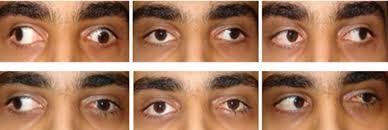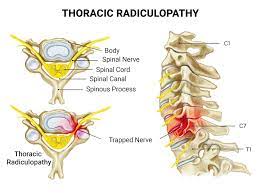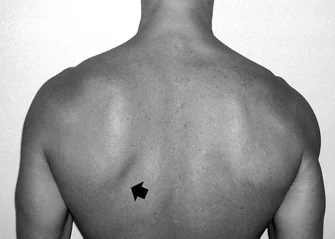Duane Retraction Syndrome
Duane Retraction Syndrome is an eye condition that a person is born with that affects how far the eyes may move from left to right. The eye-opening can get smaller when a person looks in a particular direction. Severe cases can require surgery.
Table of Contents
What is Duane Retraction Syndrome?
- Duane syndrome is a type of strabismus, an eye misalignment that is congenital (something a person is born with).
- If a person has Duane syndrome, a person will have difficulties moving the eyes from side to side.
- A person can have trouble with one or both eyes looking inward toward the nose or outward toward the ear.
- A person can also have trouble looking upward or downward.
- Along with the eyes crossing, or being out of alignment with each other, the eyelids might move when a person tries to move the eyes.
- This is because the nerves that control the muscles in the eyes do not work correctly.
- About 80% to 90% of Duane syndrome cases are unilateral, which means they affect only 1 eye.
- The left eye is usually affected.
Are there other names for Duane syndrome?
- There are several names for Duane syndrome. They involve:
- Duane retraction syndrome.
- Eye retraction syndrome.
- Retraction syndrome or congenital retraction syndrome.
- Duane radial ray syndrome.
- Stilling-Turk-Duane syndrome.
Types of Duane Retraction Syndrome
There are different 3 types of Duane syndrome: type 1, type 2, and type 3.
Type 1 Duane syndrome
- Duane syndrome type 1 is the most normal type.
- It accounts for about 78% of all cases.
- If a person has type 1, the person will have trouble moving the eye outward toward the ear.
- The eye will be able to cross inward toward the nose, but the eye-opening typically becomes smaller and the eyeball retracts.
- The eye can look crossed toward the nose (esotropia).
Type 2 Duane syndrome
- Duane syndrome type 2 is the less common type.
- It accounts for about a percent of individuals with the condition.
- If a person has type 2, a person has a limited ability to move the eyes inward toward the nose.
- The person will be able to turn the eye outward toward the ear but the eye-opening typically becomes smaller and the eyeball retracts.
- The eye can look turned out toward the ear (exotropia).
Type 3 Duane syndrome
- Duane syndrome type 3 accounts for about 15% of total cases.
- If a person has type 3, the ability to move the eyes in either direction is restricted.
- Also, the eye-opening can become smaller and the eyeball retracts with particular gazes.
How common is Duane syndrome?
- It is stated that 4% of the population of the U.S., or some 13 million individuals, have strabismus.
- It is further stated that about 1% to 5% of the total number of individuals with strabismus have Duane syndrome.
- Duane syndrome is slightly more normal in individuals assigned female at the time of birth (AFAB) than people assigned male at birth (AMAB).
What are the signs and symptoms?
Signs and symptoms of Duane syndrome, some of which can be seen in infants, can involve :
- An unusual position of the head.
- Patient with Duane retraction syndrome occasionally turns their heads to the side to straighten their eyes.
- Eyes that do not point in the same direction, either at some times or all times (strabismus).
- One eye — the one that is involved — has a lower vision (amblyopia, or lazy eye).
- One eye looks smaller than the opposite because the eyelids narrow.
- Eyes that move either up or down when a person is looking a certain way. This is known as an up-shoot or down-shoot.
Other conditions related to Duane syndrome:
Duane syndrome does not usually occurs with other conditions, but it sometimes does. These conditions can involve:
- Hearing disorders.
- Goldenhar syndrome.
- Problems with the spine or vertebrae.
There can also be other eye-related conditions that occur along with Duane syndrome, involving:
- Cataract tends to the clouding of the lens of the eye.
- Microphthalmos, which means that the eye is unusually small.
- Nystagmus is a condition in which the eyes move ungovernable
- Crocodile tears syndrome, where someone with Bell’s palsy sheds tears while eating or drinking.
What causes Duane Retraction Syndrome?
- Duane syndrome is genetic, but not typically inherited.
- The movement issues are because of problems with the cranial nerves, or the nerves that control the way the eyes move.
- Duane syndrome can occur more frequently in individuals who have been exposed to thalidomide in utero.
- Only about 10% of individuals with Duane syndrome have other family members with the condition.
- In cases that run in the family, Duane syndrome is generally bilateral (it affects both eyes).
- If a person inherits Duane syndrome, it occurs because a variant of CHN1, MAFB, or SALL4 is passed down.
- The pattern for inheritance in Duane syndrome, known as “autosomal dominant,” means that it happens similarly in individuals AMAB and individuals AFAB, and it may be inherited if just one parent has Duane syndrome.
How is Duane syndrome diagnosed?
- The doctor will take a complete medical history and will do a thorough eye exam.
- They will measure how much misalignment is present and test how far the eyes, or the child’s eyes, may move from side to side.
- The doctor can also want to order tests for other conditions that might be linked to Duane syndrome.
- There is some other condition called 6th cranial nerve palsy that is very similar to Duane syndrome but is much less common than Duane syndrome.
How is Duane syndrome treated?
- Treatment will be based on age, severity, and other illnesses a person might have.
- Some individuals with Duane syndrome won’t need treatment.
- They will just require to keep up a regular appointment schedule with their eye care doctors.
- Individuals who also have amblyopia can benefit from patching their good eye so the weaker one becomes stronger.
- If a person has a severe case of Duane syndrome, a person can require surgery on the eye muscles.
- The surgery may not fix the nerve problem but it may change the position of eye muscles to align an abnormal head posture, straighten eyes when looking straight ahead, and improve up-shoots/down-shoots.
Standard Therapies
- Standard management of Duane syndrome (DS) can involve surgery.
- The aim of surgery is the elimination or improvement of an unacceptable head turn, the elimination or decrease meant of significant misalignment of the eyes, the reduction of severe retraction, and the improvement of upshoots and down shoots.
- Surgery does not eliminate the fundamental abnormality of innervation and no surgical technique has been totally successful in eliminating abnormal eye movements.
- Simple horizontal muscle recession procedures, vertical transposition of the rectus muscle, or combinations of the two can be successful in improving or eliminating head turns and misalignment of the eyes.
Physiotherapy treatment Duane Retraction Syndrome
Pencil pushups

- Pencil pushups are simple ocular workouts that get both eyes aimed at the same fixed point.
- They are also identified as near points of convergence exercises.
- Start by grasping a pencil out at arm’s length, pointing away from the patient.
- Focus the glare on the eraser or a letter or numeral on the side.
- Gently move the pencil toward the tip of the nose.
- Keep it in focus for as long as a person can, but stop once the vision gets blurry.
Barrel cards
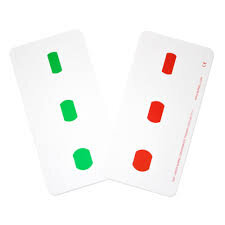
- This is a handy exercise for exotropia.
- Draw three barrels of progressive size in red lengthwise on 1 side of a card.
- Do the same thing in green on the other side.
- Grasp the card lengthwise and vertically opposed to the nose so that the largest barrel is furthest away.
- Glare at the far barrel until it becomes one image with both colors and the other two barrel images have doubled.
- Stabilize the gaze for about five seconds.
- Then do it again with the middle and smallest barrel images.
Coloring within the lines
- Many babies love to color. Motivating the child to color in a coloring book is an excellent way to sneak in an eye exercise.
- The goal here is to have the child color within the lines, not just on the page.
- Prior to starting this exercise, make the child has sharpened coloring pencils or crayons without dull points.
- To perform this exercise:
- Select a coloring book with simple pictures that have strongly delineated lines.
- Put an eye patch over the child’s stronger eye.
- Suggest them to carefully color the objects on the page and stay within the lines.
- Be sure to supervise the child so that they do not remove the eye patch.
Brock string exercise

- This exercise helps the eyes learn how to work combine to focus on an object.
- This exercise requires a Brock string or a homemade string.
- A Brock string is a white string that is approximately fifteen feet long.
- It has colorful wooden beads on it, which may be moved around.
- Do not use an eye patch when performing this exercise.
- Shop for a Brock string online.
To perform the Brock string exercise:
- Hitech a loop on both ends of the Brock string.
- Use one loop to attach the string to a door or other fixed object.
- Position the beads along the string so that one is close to the doorknob (far fixation), one is around three feet away from the person (middle fixation), and one is six inches from the nose (near fixation).
- Stand directly in front of the doorknob.
- Use the other string loop to put the Brock string around the finger.
- Hold the string flush along the upper lip, right under the nose.
- The cord should be stretched tight. If it is not tight, take a moment to adjust and shorten it by making the loops larger.
- Look at the bead closest to a person, and make sure a person sees one bead, not two. If a person sees two beads, move the bead until a person sees one.
- A person should see two strings as if one string is coming from each eye.
- The strings should form an X shape.
- As a person moves the bead closer to the nose, the strings should meet exactly at the bead, and take on a V shape.
- Repeat by shifting the focus to the middle fixation bead and then the far fixation bead.
- As the weak eye becomes stronger, the bead should be able to be moved closer to the eyes, until it is only 1 inch away.
Video games
- Specially designed video games that are played while wearing goggles have shown a pledge for lazy eyes.
- These games are played dichoptically, meaning every eye views something various through the goggles, like high or low-contrast images.
- For adults, a dichoptic version of Tetris has been shown by scientists at the Health Centre to be effective for strengthening the weaker eye.
- Playing video games with an eye patch can also have a beneficial effect. Small research
- indicated that both action and non-action video games had benefits for adults with lazy eyes.
Dot card
For this exercise, a patient will work to maintain a single picture of a dot on a card with both eyes. To use a dot card:
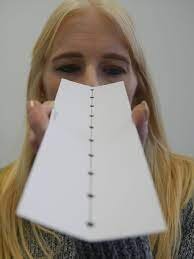
- Draw dots on a paper card made out of cardboard or another type of stiff paper.
- Grasp the card lengthwise and touch the nose so that the line of dots is directly in front of the face.
- Tilt the card down slightly.
- Focus on the dot farthest away from a person.
- If the eyes are converging correctly, the pattern of dots should look like they are in an A shape.
- The dot a person is focusing on should be singular and not blurry.
- Focus on the next dot in the line, and then the next, holding each dot in focus for a count of five.
- If the eyes are continuing to converge correctly, an X shape will form.
- When a person reaches the dot that is closest to her, the dots in the back will double and form a V shape.
Barrel convergence cards

- This exercise is used initially to treat exotropia, a form of strabismus.
- A person may buy these cards or make them themselves.
- To make barrel convergence cards, draw 3 red barrels on one side of the card in a lengthwise pattern.
- The barrels should be larger in size toward the bottom of the card.
- Draw corresponding barrels on the opposite side of the card in green.
To use barrel convergence cards:
- Grasp the card lengthwise touching the nose so that the three barrels appear in a vertical line, pointing away from the face.
- The largest barrel should be farthest from the nose.
- Stare at the largest barrel until a person sees one image with both colors.
- The other 2 barrels should appear doubled.
- Hold the gaze for the count of five, then move on to each smaller barrel, repeating the exercise.
Puzzles
- Putting together jigsaw puzzles with an eye patch may help strengthen the weaker eye.
- There is a very biggest range of jigsaw puzzle types. Be sure to opt for age-appropriate puzzles that won’t frustrate the child with their complexity.
Reading
- If the child may read, have them read an age-appropriate book they enjoy for at least thirty minutes daily with a patch over their stronger eye.
Prevention
- At this time, there is no way to prevent Duane syndrome from happening.
- Thalidomide, the medication that may cause Duane syndrome (in addition to many other congenital conditions), is no longer available.
FAQ
Some individuals with Duane syndrome develop a “lazy eye” (amblyopia), a condition that can cause vision loss in the affected eye. Duane syndrome generally only happens in one eye and is not connected with other signs or symptoms.
DS does not cause blindness and does not generally lead to other health issues. In very infrequent cases, it has been linked to problems with bones, eyes, ears, kidneys, and the nervous system. Most of the time, only one eye is affected -generally the left one.
Duane syndrome (DS) is an eye movement disorder present at birth (congenital) distinguished by horizontal eye movement limitation: a restricted ability to move the eye inward toward the nose (adduction), the outer side towards the ear (abduction), or in both directions.
Duane syndrome, also known as Duane retraction syndrome (DRS), is a congenital and non-progressive type of strabismus because of abnormal development of the 6th cranial nerve. It is distinguished by difficulty rotating one or both eyes’ outer sides (abduction) or inward (adduction).
Type 3 includes difficulty in moving the eyes in both directions. However, Duane’s syndrome will not exclude a person from wearing contact lenses if that is what a person prefers. Look for the optometrist for a full eye test, and a prescription to gain an accurate reading of the level of correction a person needs.

